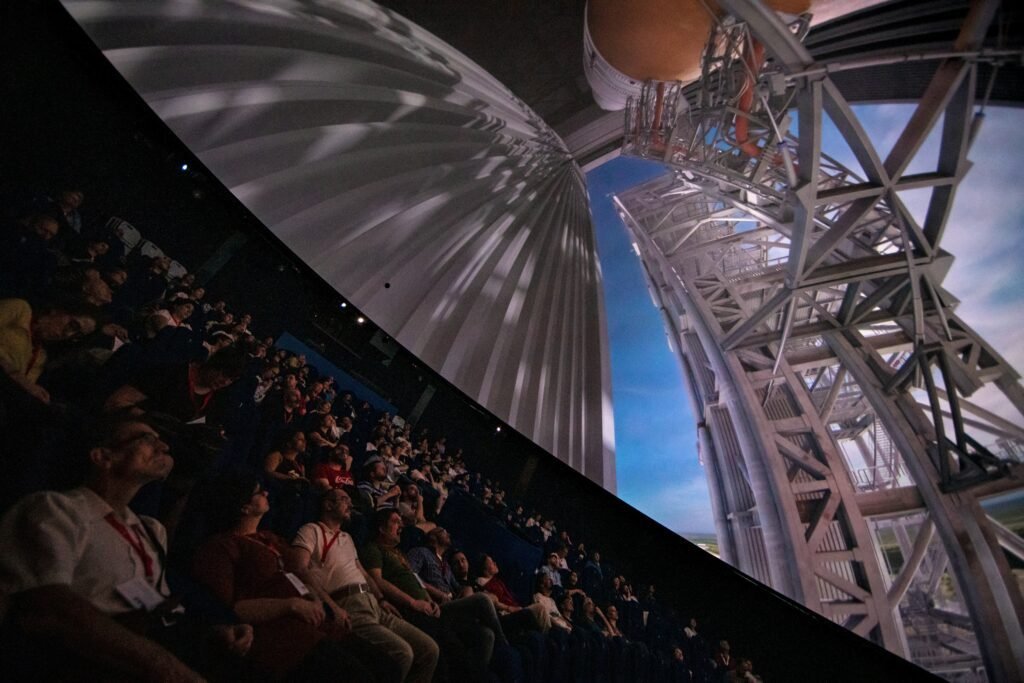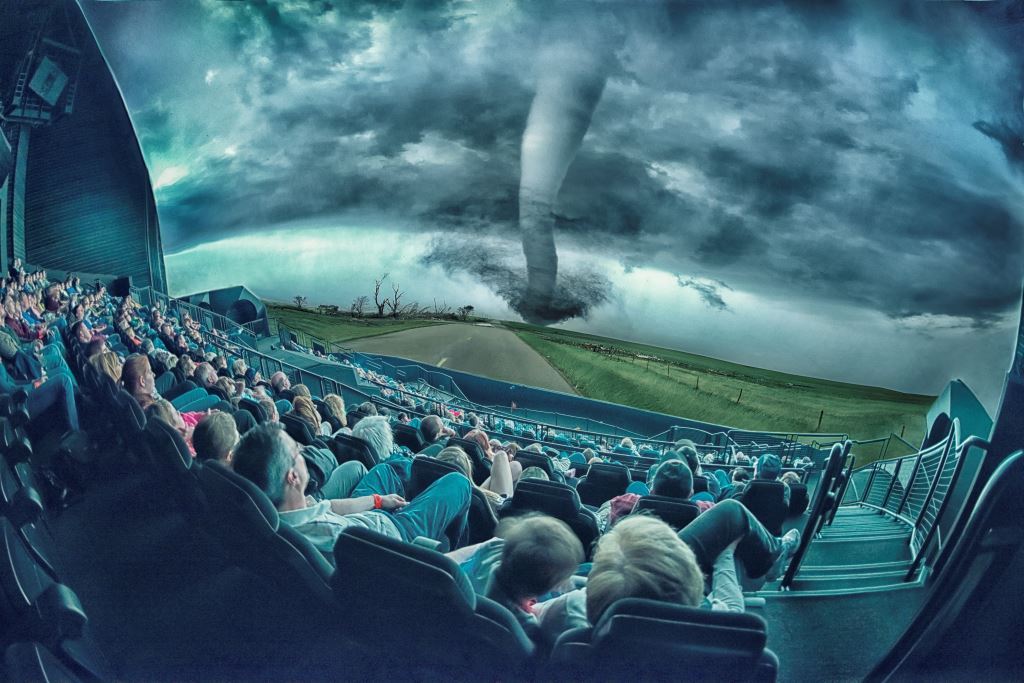Giant screen theaters are a marvel of modern technology, offering viewers an immersive and larger-than-life cinematic experience. One such example is the giant screen theater at Houston’s Museum of Natural Science. Equipped with state-of-the-art, 4K digital projection, this theater transports audiences into a world of breathtaking visuals.
The giant screen at Houston’s Museum of Natural Science measures an impressive 60′ x 80′ feet, making it nearly eight stories high. This massive canvas allows for images of unparalleled size and clarity to come to life. The 4K digital projection technology ensures that every detail is rendered with precision, creating a truly mesmerizing visual spectacle.

To complement the stunning visuals, the giant screen theater is equipped with a superb six-track sound system. This ensures that the audience is not only visually immersed but also enveloped in a rich and immersive audio experience. The combination of the giant screen and the powerful sound system creates a truly impactful cinematic experience.
The Impact of Giant Screen Theaters
The impact of giant screen theaters extends far beyond Houston. The International Planetarium Association has nearly 500 members across 50 countries and there are estimated 3,000 planetarium style 360 giant screens equipped with digital projection technology across the globe. In addition IMAX is a proprietary system of high-resolution cameras, film formats, film projectors, and theaters known for having very large screens with a tall aspect ratio (approximately either 1.43:1 or 1.90:1) and steep stadium seating, with the 1.43:1 ratio format being available only in few selected locations.
Mark Slater, a renowned composer, has composed soundtracks specifically tailored for giant screen theaters and fulldome 360 digital theaters around the world. His work has been enjoyed by audiences in countries like China, India, Russia, Japan, Europe, and the USA. Slater’s soundtracks add an extra layer of depth and emotion to the already awe-inspiring visuals, further enhancing the immersive experience.
The Immersive Experience
Immersive media is so-called for the ability to immerse people within an environment. Unlike traditional flat-screen cinema, television, or other flat screens, when you’re interacting with immersive media, you’re not just viewing a picture confined to a frame.
In the case of 3D content, you can see a flat sphere of visual content around you which adapts according to your position or view, managed by 3 degrees of freedom or 3DoF. In the case of extended reality (AR, VR, and MR), immersive media would map your experience onto a physical space, allowing for deeper interactions. This is known as 6 degrees of freedom, or 6DoF.

Most kinds of immersive media fall into either 3DoF or 6DoF categories. Options include:
- Virtual reality: VR is the most commonly referenced content in immersive media. It involves using a virtual or digital environment to replace a real-world space. VR fully immerses the user in a digital world through head-mounted displays and sensors.
- Augmented reality: Augmented reality, or AR brings the digital content into a real-world environment. This allows for the enhancement, rather than the replacement of your physical surroundings.
- Mixed reality: Mixed reality blends the real and digital world in an environment where they can co-exist. Mixed reality experiences can include things like holograms or holoportation, and they allow for a much deeper level of interaction than AR.
- 3D content: 3D videos and images allow you to surround yourself with a kind of unique image or video. This allows for immersion within the media, but there’s usually no way of interacting with the content directly, without the use of a smartphone or similar device.
- Fulldome: Fulldome video utilizes either a fisheye lens or multiple projectors that use edge blending to cover a hemispherical surface. The dome, horizontal or tilted, is filled with real-time (interactive) or pre-rendered (linear) computer animations, live capture images, or composited environments. Fulldome environments have evolved from numerous influences, including immersive art and storytelling, with technological roots in domed architecture, planetariums, multi-projector film environments, flight simulation, and virtual reality.
Bringing Stories to Life: The Visual Impact of Giant Screen Theaters
Now that we’ve explored some of the main elements used to create immersive experiences, let’s dive a bit deeper into the specifics of what makes giant screen theaters so unique and compelling.
- Enormous Screen Size: One of the key features that make giant screen theaters stand out is their size. These colossal screens can reach up to 100 feet in height, completely dwarfing the average movie theater screen. The effect is breathtaking and genuinely larger-than-life, enabling viewers to become completely lost in the imagery before them.
- Enhanced Resolution and Detail: Giant screen theaters often feature advanced projection technologies that result in a superior resolution. This means crystal-clear images that allows viewers to see every detail of the visuals, adding a remarkable sense of realism to the experience.
- Immersive Sound: The sound equipment in these theaters is just as impressive as the screens. With systems such as Dolby Atmos, viewers are surrounded by sound from all directions, properly tuned to the size and acoustics of the theater, which adds an extra level of immersion to the viewing experience.
- Unique Seating Arrangement: In a giant screen theater, even the seating layout is designed to enhance immersion. The seats are typically arranged in a steep stadium-style layout, ensuring a clear, unobstructed view of the screen from every angle.
- Specialized Content: Lastly, many giant screen theaters specialize in showcasing high-quality 3D films, documentaries, and educational content that capitalize on their technologies, bringing viewers face-to-face with the wonders of nature, space exploration, and more. These experiences are both spectacular and informative, the essence of edutainment at its best.
With its rich combination of size, sound, and specialized content, a giant screen theater offers a viewing experience that is truly out of this world.
Giant screen theaters attract over 155 million viewers annually worldwide
In conclusion, giant screen theaters like the one at Houston’s Museum of Natural Science offer viewers an unparalleled cinematic experience. With their massive screens, state-of-the-art projection technology, and immersive sound systems, these theaters transport audiences into a world of larger-than-life visuals and captivating storytelling. Whether it’s in Houston or across the globe, giant screen theaters continue to captivate and awe audiences with their incredible size, clarity, and impact.


Pingback: “Through the Eyes of an Otaku” wins at BRNO - Mark Slater